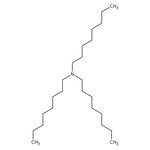Search Thermo Fisher Scientific
Tri-n-octylamine, 95 %, Thermo Scientific Chemicals



Tri-n-octylamine, 95 %, Thermo Scientific Chemicals
Identifiants chimiques
Spécifications
Description
This Thermo Scientific Chemicals brand product was originally part of the Alfa Aesar product portfolio. Some documentation and label information may refer to the legacy brand. The original Alfa Aesar product / item code or SKU reference has not changed as a part of the brand transition to Thermo Scientific Chemicals.
La tri-n-octylamine est utilisée comme agent d’extraction pour les acides organiques comme l’acide trichloroacétique, l’acide succinique, l’acide acétique et les métaux précieux. Elle est également utilisée comme solvant et intermédiaire dans la fabrication de produits pharmaceutiques. De plus, Elle est utilisée dans la préparation de composés d’ammonium quaternaire, d’agroproduits chimiques, de surfactants, d’additifs pour lubrifiants, d’inhibiteurs de corrosion, d’accélérateurs de vulcanisation et de colorants.
Solubilité
Miscible au chloroforme. Immiscible avec l’eau.
Remarques
Sensible à l’air. Incompatible avec les agents oxydants forts, le dioxyde de carbone, les acides, les chlorures acides et les anhydrides acides.
Figures
Documentation et téléchargements
Certificats
Foire aux questions (FAQ)
Citations et références
Sécurité et manipulation
Classification of the substance or mixture
CLP classification - Regulation(EC) No 1272/2008
Label Elements
Signal Word
Danger
Hazard Statements
H315 - Causes skin irritation
H319 - Causes serious eye irritation
H360 - May damage fertility or the unborn child
H372 - Causes damage to organs through prolonged or repeated exposure
H410 - Very toxic to aquatic life with long lasting effects
Precautionary Statements
P280 - Wear protective gloves/protective clothing/eye protection/face protection
P302 + P352 - IF ON SKIN: Wash with plenty of soap and water
P305 + P351 + P338 - IF IN EYES: Rinse cautiously with water for several minutes. Remove contact lenses, if present and easy to do. Continue rinsing
P308 + P313 - IF exposed or concerned: Get medical advice/attention
P332 + P313 - If skin irritation occurs: Get medical advice/attention
Additional EU labelling
Restricted to professional users